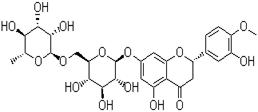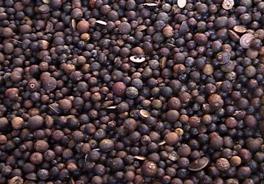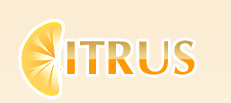HESPERIDIN
Identification
Ingredient |
Hesperidin |
Structure:
 |
Synonyms |
(s)-7-((6-o-(6-deoxy-alpha-l-mannopyranosyl)
-beta-d-glucopyranosyl)oxy)-2,3-dihydro-5-hydroxy-2-(3-hydroxy-4-methoxyphenyl)-4h-1-benzopyran-4-one; vitamin p |
Molecular Formula |
C28H34O15 |
Molecular Weight |
610.57 |
CAS no. |
520-26-3 |
EINECS |
208-288-1 |
Description
The flavonoid hesperidin is a flavanone glycoside (glucoside) comprised of the flavanone (a class of flavonoids) hesperitin and the disaccharide rutinose. Hesperidin is the predominant flavonoid in lemons and oranges,. The peel and membranous parts of these fruits have the highest hesperidin concentrations,especially in immature little citrus fruits.Orange juice containing pulp is richer in the flavonoid than that without pulp. Sweet oranges (Citrus sinensis) and tangelos are the richest dietary sources of hesperidin. Hesperidin is classified as a citrus bioflavonoid.
Hesperidin, in combination with a flavone glycoside called diosmin, is used in Europe for the treatment of venous insufficiency and hemorrhoids. Hesperidin, rutin and other flavonoids thought to reduce capillary permeability and to have anti-inflammatory action were collectively known as vitamin P. These substances, however, are not vitamins and are no longer referred to, except in older literature, as vitamin P.
Hesperidin is a solid substance with low solubility in water. It is, however, much more soluble in water than its aglycone hesperetin.
Scientific support
Hesperidin may have antioxidant, anti-inflammatory, anti-allergic, hypolipidemic, vasoprotective and anticarcinogenic actions.
Although some studies indicate that hesperidin has antioxidant activity in vivo, others do not demonstrate antioxidant activity in vitro. The possible anti-inflammatory action of hesperidin is probably due to the possible anti-inflammatory action of its aglycone hesperetin. Hesperetin appears to interfere with the metabolism of arachidonic acid as well as with histamine release. Hesperetin appears to inhibit phospholipase A2, lipoxygenase and cyclo-oxygenase. There is evidence that hesperetin inhibits histamine release from mast cells, which would account for the possible anti-allergic activity of hesperidin.
Again, the possible hypolipidemic effect of hesperidin is probably due to hesperetin's possible action in lipid lowering. Hesperetin may reduce plasma cholesterol levels by inhibition of 3-hydroxy-3-methylglutaryl coenzyme A (HMG CoA) reductase, as well as acyl coenzyme A: cholesterol acytransferase (ACAT). Inhibition of these enzymes by hesperetin has been demonstrated in rats fed a high cholesterol diet.
The mechanism of hesperidin's possible vasoprotective action is unclear. Animal studies have shown that hesperidin decreases microvascular permeability. Hesperidin, itself or via hesperetin, may protect endothelial cells from hypoxia by stimulating certain mitochondrial enzymes, such as succinate dehydrogenase.
The mechanism of hesperidin's possible anticarcinogenic action is also unclear. One explanation may be the inhibition of polyamine synthesis. Inhibition of lipoxygenase and cyclo-oxygenase is another possibility.
Application
Hesperidin has demonstrated some ability to favorably affect lipids and to treat some vascular disorders in humans. Other claims made for hesperidin are based on in vitro and animal studies. These include claims that hesperidin is useful in cancer and immune disorders. There are also claims that hesperidin is an anti-allergen and anti-inflammatory agent based on results from animal experiments.
Hesperidin is present in nutritional supplements as vitamin C with bioflavonoids. Typical dose in these products is about 20 mg. Hesperidin is available in hesperidin-complex supplements. Doses for this type of supplement are usually 500 mg to 2 grams daily. In Europe, hesperidin is available for the management of venous insufficiency and hemorrhoids in a combination product with diosmin. A 500-mg dose of this combination product is comprised of 50 mg of hesperidin and 450 mg of diosmin. Dose for this mixed flavonoid product, for the above conditions, is 1 to 3 grams daily. Another flavonoid, hesperidin methyl chalcone, is often marketed in formulations with hesperidin. This is a different flavonoid, and very few studies have been performed using it.
Availability
Commercial Hesperidin is obtained by extraction from immature citrus fruit.

Dried immature citrus fruit
Warning:
Above information is only knowledge,not an instruction of usage for this product. The owner of this webiste should not be responsible for any damage because of misuse of the product
|



